Special Feature: Products Sally Recommends
The Javagirl Goes A-Cupping
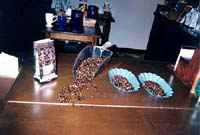 I've always wanted to know the real difference between Guatemalan and Ethiopian coffee. Or Sumatran and Colombian. Sure, I know they're grown in different parts of the world, but are they really that different? is the difference in taste and smell, or does one coffee pack a punch while the other is an easy breeze? I decide to go to the folks who should know: Peet's Coffee and Tea, a California roaster/retailer which offers a "Coffee 101" class to its customers to answer these very questions. On the week I set aside for my research, no classes are on tap, but since I'm a regular at my neighborhood store (and a coffee columnist to boot), I get the gracious Peetsters to agree to a private cupping. Luckily, I've got a couple of German houseguests around (my friends Friedrike and Birgit), so I submit three palates to the wonders and virtues of coffees from around the world.
I've always wanted to know the real difference between Guatemalan and Ethiopian coffee. Or Sumatran and Colombian. Sure, I know they're grown in different parts of the world, but are they really that different? is the difference in taste and smell, or does one coffee pack a punch while the other is an easy breeze? I decide to go to the folks who should know: Peet's Coffee and Tea, a California roaster/retailer which offers a "Coffee 101" class to its customers to answer these very questions. On the week I set aside for my research, no classes are on tap, but since I'm a regular at my neighborhood store (and a coffee columnist to boot), I get the gracious Peetsters to agree to a private cupping. Luckily, I've got a couple of German houseguests around (my friends Friedrike and Birgit), so I submit three palates to the wonders and virtues of coffees from around the world.
Our hosts for this cupping are Jay Mendoza, who clearly enjoys his job, and his trusty colleague Amy Whitehead, both employees of the Peet's on Fillmore Street in San Francisco. Turns out that my gang of three are rank amateurs at this next to Jim Reynolds, Peet's coffee buyer and master roaster. Reynolds attends daily cuppings at which he has at least two dozen tastes. That's one primed palate.
Jay launches into the prelims, during which time we learn that Peet's carries thirty-three varietals and blends from three major coffee-growing regions, namely The Americas (Latin America and Mexico), Arabia (Africa) and the Pacific Islands (glamorous names like Java and Sumatra). Peet's always uses arabica beans, whose flavor is more complex and intense, as opposed to the lower-grade robusta beans often found in vacuum-packed coffee. A cupping, Jay tells us, is much like a wine tasting in that we are looking for body, acidity and flavor. We are advised to smell the coffee first, then slurp it, so as to let in air along with our gulp. We can then ingest the coffee, or simply swirl it around our palates and spit it out (spittoon provided).
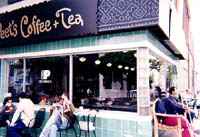 "Cupping" coffee is usually prepared in a six-ounce cup or glass, with the ratio being six ounces of water to two tablespoons of coffee. This is the best ratio for tasting as well as brewing. Things to keep in mind are the use of fresh water (purified is best) and a consistent grind (whatever is best for your machine). Jay proceeds to recommend a press pot as the ideal brewing tool as this type of coffee pot produces a direct infusion. With a press pot, the coffee mixes directly with the water since there is no filter involved. You may get a slightly muddy cup, but at least you've extracted the fullest possible flavor. Second choice for coffee brewing would be a gold filter, since this filter doesn't remove any flavor from the coffee, as would be the case with a paper filter. Paper filters have a tendency to filter out coffee oils and grounds as well as flavor, plus your cup tends to pick up a bit of the paper's taste. Once brewed, coffee should not sit over heat for more than thirty minutes; any longer and you lose flavor at a rapid rate. For those who want their coffee warm all morning long, a pre-heated Thermos is a good idea.
"Cupping" coffee is usually prepared in a six-ounce cup or glass, with the ratio being six ounces of water to two tablespoons of coffee. This is the best ratio for tasting as well as brewing. Things to keep in mind are the use of fresh water (purified is best) and a consistent grind (whatever is best for your machine). Jay proceeds to recommend a press pot as the ideal brewing tool as this type of coffee pot produces a direct infusion. With a press pot, the coffee mixes directly with the water since there is no filter involved. You may get a slightly muddy cup, but at least you've extracted the fullest possible flavor. Second choice for coffee brewing would be a gold filter, since this filter doesn't remove any flavor from the coffee, as would be the case with a paper filter. Paper filters have a tendency to filter out coffee oils and grounds as well as flavor, plus your cup tends to pick up a bit of the paper's taste. Once brewed, coffee should not sit over heat for more than thirty minutes; any longer and you lose flavor at a rapid rate. For those who want their coffee warm all morning long, a pre-heated Thermos is a good idea.
In addition to fresh water and a good filtering system, fresh coffee is key to brewing the perfect cup. Peet's keeps their coffee in house no more than seven days; you should strive to keep your coffee no longer than seven days as well. An airtight container is the best storage method, ideally placed in a dark cupboard or pantry. If you do keep your coffee longer than seven days, transfer it to the refrigerator at that point (never the freezer). What you're trying to do is keep your coffee away from air and water, two things which will quickly break it down. The standard rule of thumb is one pound of coffee for every thirty cups, a handy measuring stick for weekly coffee purchases.
Ready to begin the cupping, Jay deposits fresh coffee grounds into five small glasses, filling each half-way with water. This two-minute prodecure will allow the coffee to "bloom" and help draw out the aroma (it works!). He then fills the glasses with water and lets the coffee steep for a maximum of five minutes. At this point, we're ready to taste. On the way over to Peet's, my houseguests and I had been thinking about what terminology we might use during the cupping to sound halfway informed: complex? full-bodied? bitter? We're not sure, but we think that complex might be the way to go...
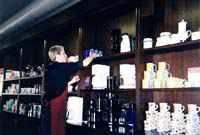 Jay starts by telling us that we'll be tasting five different coffees, one from each of the Peet's "regions" along with a blend and a decaf. All of the roasts are "full-city" roasts, which means they are roasted between twelve and fifteen minutes and contain less caffeine than quicker roasts. Contestant number one is a Colombian coffee, and Jay asks us to tell him what we find in this brew. We each ladle out a few spoonfuls of brewed coffee into our respective cups and start to examine. I notice that the Colombian brew is lighter in color than I expected, almost caramel in color. It also has a pleasant smell. I take a big slurp (what fun!) and swallow. My initial sensation is kind of tinkly and sparkly. This coffee is by no means overroasted, but the final bite is decidedly acidic. I report this to Jay, who agrees with me. "Colombian coffees are more acidic," he tells us, "although they start very bright. Arabica coffees grown in Latin America are often grown on very volcanic soil, which contributes to the acidity. These plantations get good growing weather -- lots of rain, and the water run-off helps the plants. Even the surrounding crops contribute to the flavor. We tend to forget that coffee comes from a fruit, the seed of a cherry. Where Colombian coffee is concerned, I find it more caramel-flavored but also peppery. It reminds me of a Caesar salad: tangy and a bit peppery on top."
Jay starts by telling us that we'll be tasting five different coffees, one from each of the Peet's "regions" along with a blend and a decaf. All of the roasts are "full-city" roasts, which means they are roasted between twelve and fifteen minutes and contain less caffeine than quicker roasts. Contestant number one is a Colombian coffee, and Jay asks us to tell him what we find in this brew. We each ladle out a few spoonfuls of brewed coffee into our respective cups and start to examine. I notice that the Colombian brew is lighter in color than I expected, almost caramel in color. It also has a pleasant smell. I take a big slurp (what fun!) and swallow. My initial sensation is kind of tinkly and sparkly. This coffee is by no means overroasted, but the final bite is decidedly acidic. I report this to Jay, who agrees with me. "Colombian coffees are more acidic," he tells us, "although they start very bright. Arabica coffees grown in Latin America are often grown on very volcanic soil, which contributes to the acidity. These plantations get good growing weather -- lots of rain, and the water run-off helps the plants. Even the surrounding crops contribute to the flavor. We tend to forget that coffee comes from a fruit, the seed of a cherry. Where Colombian coffee is concerned, I find it more caramel-flavored but also peppery. It reminds me of a Caesar salad: tangy and a bit peppery on top."
Birgit, Friedrike and I marvel at Jay's wealth of coffee knowledge coupled with his lyrical coffee prose. Birgit also tells Jay that the Colombian brew leaves a pleasant taste in her mouth but no aftertaste in her throat. "Latin Americans tend to be the cleanest roasts," Jay notes. "It's there and then it's gone. I recommend them as morning coffees because they're brisk."
Contestant number two is an Ethiopian Fancy, which comes from Africa. Jay mentions the old legend of the first coffee tree, which came from Ethiopia as well. Peet's also carries Kenyan coffee as well as a Yemeni roast, shipped in from the port of Mocha. This allows Jay to share another old coffee tale, one with which I am not familiar. It turns out that coffee from Mocha had a rather chocolatey taste, so the name ("mocha") eventually became associated with chocolate itself. I pour some of the Ethiopian into my cup and find it smells almost lemony! It also tastes much smoother than the Colombian. "African coffees are much fruitier and floral," Jay informs us. "Some days they're like a pasture full of flowers. It's also medium-bodied, so it doesn't overwhelm the palate. I consider it an anytime-of-day coffee: you can probably wake up to it and go to bed with it, too."
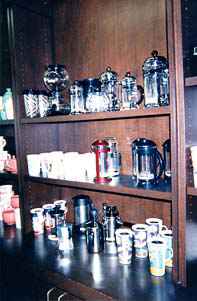 Our next coffee is a Sumatra from the Pacific Islands. I find it light in color and very nutty in taste. It even seems complex! "The taste here is totally different from the smell," Birgit pipes up. "The aromas are opposite from the tastes with Pacific Rim coffees," the ever-knowledgeable Jay informs us. "There's a certain earthiness to it, almost toasty. Pacific Rim coffees tend to be nutty, woody, rich in texture -- even a little heavier." I start to think of wine aged in an oak barrel, where much of the woody flavor is imported. This coffee's woodiness is natural: it comes from within, the flavor coating your mouth. Like the two coffees before it, it is delicious, but in its own way.
Our next coffee is a Sumatra from the Pacific Islands. I find it light in color and very nutty in taste. It even seems complex! "The taste here is totally different from the smell," Birgit pipes up. "The aromas are opposite from the tastes with Pacific Rim coffees," the ever-knowledgeable Jay informs us. "There's a certain earthiness to it, almost toasty. Pacific Rim coffees tend to be nutty, woody, rich in texture -- even a little heavier." I start to think of wine aged in an oak barrel, where much of the woody flavor is imported. This coffee's woodiness is natural: it comes from within, the flavor coating your mouth. Like the two coffees before it, it is delicious, but in its own way.
Next up is the Sierra Dorada blend, Peet's first new blend in twelve years. Sierra Dorada, which translates to "golden mountains," uses beans from each growing region. Peet's actually held a contest to name its newest baby and the winner was awarded a weekend in Calistoga. I remark that the winner should have been given a week at a coffee plantation and both Jay and Amy agree, especially Amy, who tells us she had submitted "Amy's Blend" in the coffee-naming contest. Everyone chuckles at her losing entry. We start to examine our coffee, which looks much darker than the previous brews. "It seems to add on flavors," Friedrike notes. "This one is really complex!" Indeed it is, an earthy, warm cup possessing some of the spicy notes of the Latin American coffees together with the pleasant aftertaste found in Pacific Rim brews.
Our last sip is the Decaf Special, a blend of Latin American and Indonesian coffees. Jay clues us in to the chemical decaffeination process which was used for this blend. Methylene chloride seems to be the most efficient way to remove caffeine from coffee with no discernible aftertaste. The beans are soaked in a chemical solution to extract caffeine and wax (a natural residue), then dried and shipped. The Swiss-water-process form of decaffeination is better for both the environment and the body. In this process, the beans are soaked in water a number of times. Since caffeine is water-soluble, it rises to the top and is then scooped off. The beans are then dried and shipped. Being more labor-intensive, Swiss-water-process beans are generally more expensive. Peet's wisely carries both types of decaffeinated coffee. In either form, decaffeination certainly seems to work: it would take thirty cups of decaf coffee to equal one caffeinated cup. Where our Decaf Special is concerned, we find it woody in taste and nicely flavorful.
Finished with the coffees at hand, we turn our eyes to Peet's menu board and some of the more unique selections. The Aged Indonesian Decaf is a coffee which is aged as a green bean in hefty burlap sacks. This process enhances the overall complexity of the bean. "Since it's aged, it almost has a wine-y characteristic," Jay tells us. "Aged decafs really hold up." The Arabian Mocha Sanani, most expensive coffee at Peet's at $15.45 a pound, comes from a small plantation and is a rarer coffee. "It almost tastes like blueberries!" Jay enthuses. The price point prompts me to ask Jay about a couple of other "rich" coffees with which I'm familiar. Ethiopian Peaberry, he tells me, is unique in that it comes from a smaller bean and offers a more intense flavor. Jamaica Blue Mountain may be best known because of its price, which is often $40 a pound. Neither of the last two coffees is available at Peet's. "The flavor of Jamaica Blue Mountain has dimished over the years," Jay continues, confirming something I had heard before. "A number of hurricanes have destroyed the crops and they haven't been able to fully replenish them. The closest we have in flavor to Jamaica Blue Mountain would be Arabian Mocha Sanani."
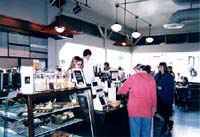 Jay and Amy have also displayed each of the coffees we tasted in an elegant dish. The shininess of the beans catches our eye. "The beans are usually dry when they come out of the roaster," Jay notes. "After a few days, you see the sheen, which indicates oil, and that means freshness. After a few more days, they'll get dry again." The one thing we did not see on Peet's menu board was flavored coffees. "We're purists here!" Jay and Amy say in unison. They are both quick to add that if we want flavor in our coffee, it's far better to add it in later, say, with a drop of vanilla or a cinammon stick after it's brewed.
Jay and Amy have also displayed each of the coffees we tasted in an elegant dish. The shininess of the beans catches our eye. "The beans are usually dry when they come out of the roaster," Jay notes. "After a few days, you see the sheen, which indicates oil, and that means freshness. After a few more days, they'll get dry again." The one thing we did not see on Peet's menu board was flavored coffees. "We're purists here!" Jay and Amy say in unison. They are both quick to add that if we want flavor in our coffee, it's far better to add it in later, say, with a drop of vanilla or a cinammon stick after it's brewed.
We leave our crash course in "Coffee 101" with tons of information and a greater appreciation for the various coffees of the world. For coffee lovers and javagirls alike, there's no better way to enjoy a leisurely coffee break.
"Coffee 101" is offered on a regular basis at Peet's stores throughout California. For more information on store locations and scheduling, call (510) 594-2100.
Note: This information was accurate when it was published. Please be sure to confirm all rates and details directly with the businesses in question before making your plans.



